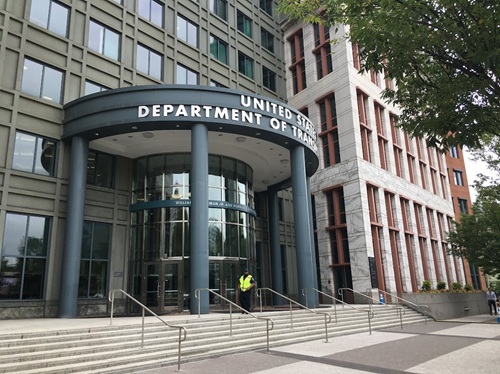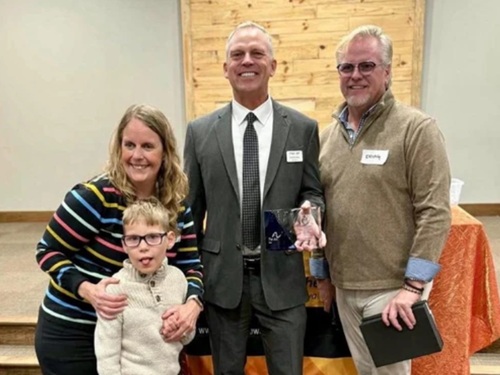You could literally feel the excitement and tension fill the West Virginia University Institute of Technology’ Van Meter Gym as middle and high school students watched the destructive testing of bridge models they built with balsa wood and Elmer’s wood glue at the 2023 West Virginia Bridge Design & Build Contest.
[Above left to right: Parker Shrewsbury and Madelyn Cole of Pikeview High School watch as WVU Tech students Luke Reynolds and Tyler Kibler put their bridge model to the test. Photo by WVU Tech.]
Sponsored for the last 20 years by the West Virginia Department of Transportation and hosted by the WVU Tech on its Beckley campus, the final round of the contest on April 1 tested the computer software and model bridge building skills of 38 sixth through 12th grade students from across the state.

[For list of the winners, click here.]
The final round consisted of two separately-judged stages: A two-hour computer software competition, followed by a three-hour round of destructive testing of balsa wood bridge models.
“Destructive testing” consisted of suspending the student’s bridge models over a 12-inch gap on tables. Contest judges slowly added sand to an empty bucket suspended from a metal hook placed in the center of the bridge model, continually adding sand to the bucket until the bridge model failed. Bridges that supported the most weight before collapsing were the winners.
The first, second, and third place winners in each stage took home plaques and anywhere from $100 to $400 in cash prizes, as well as other “swag” provide by WVDOT and WVU Tech.
[Editor’s note: The American Association of State Highway Transportation Officials oversees the national Transportation and Civil Engineering or TRAC program and its sister program RIDES – short for “Roadways In Developing Elementary Students” – to introduce students in grades K-12 to the “work world” of transportation and civil engineering. The TRAC program culminates in the annual day-long National Bridge Competition, typically held in-person at AASHTO’s Spring Meeting.]
“The computer software part of the competition tests the student’s ability to develop a lowest cost bridge with the highest structure strength capable of handling the specified traffic flow,” explained Dr. Horng-Jyh “Tigra” Yang, associate professor and geotechnical engineer, WVU Institute of Technology’s civil engineering department.

“Typically, the difference between the winners and losers is only a couple hundred dollars in bridge costs. That’s how close this competition is,” he said.
Dr. Yang added that the balsa wood bridge model portion of the contest takes that two dimensional bridge structure knowledge and applies it within a three dimensional contest.
“Moving to the three-dimensional part of the contest poses a bit of a challenge,” he said. “This is where you are building a bridge in the ‘real world’ and where the students are applying the structural knowledge they’ve learned to this point.”
Dr. Yang said this contest helps attract more students in Science, Technology, Engineering, and Mathematics or ‘STEM’ programs as well as teach them the fundamentals of civil engineering. “West Virginia, like many states, is short of engineers so we hope to build on this program to attract more students into the civil engineering field,” he noted.

“This is a great way to get more students interested in engineering,” added Hussein Elkhansa, WVDOT’s chief technology officer. “But it is also a way to get more of them interested in the transportation industry as well. Even if they don’t end up becoming engineers, we use this contest to let them know we at WVDOT have all sorts of career options open to them.”
Dustin Feazell, section head of the geospatial infrastructure information technology division at WVDOT, noted that his “favorite aspect” of the contest “is seeing the kids and seeing the looks on their faces” as they put their knowledge and bridge models to the test.
“You can see the wheels turning in their brains. They’re thinking hard, they’re focused on this contest, and it is just a pleasure to see that,” he said. “With civil engineering, it’s a very broad engineering track. They could do bridge design, roadway design, hydraulics, storm water, sewer systems, anything. Whatever track they pick in their future is, obviously, up to them; we just want to use this contest to help them get into the engineering field.”

Dr. T. Ramon Stuart, who took over as president of WVU Tech in January and noted that, “I’m a computer engineer by training, who taught the subject for many years,” explained that this contest offers a “great way” to help young men and women connect to some of the engineering opportunities in West Virginia and beyond.
“Building these bridges is symbolic of their ability to put their minds to solving problems and overcoming any obstacles to building careers in the engineering or other technology fields,” he explained.
 Top Stories
Top Stories
USDOT Issues $1B in Local Road Safety Funding
January 2, 2026 Top Stories
Top Stories

